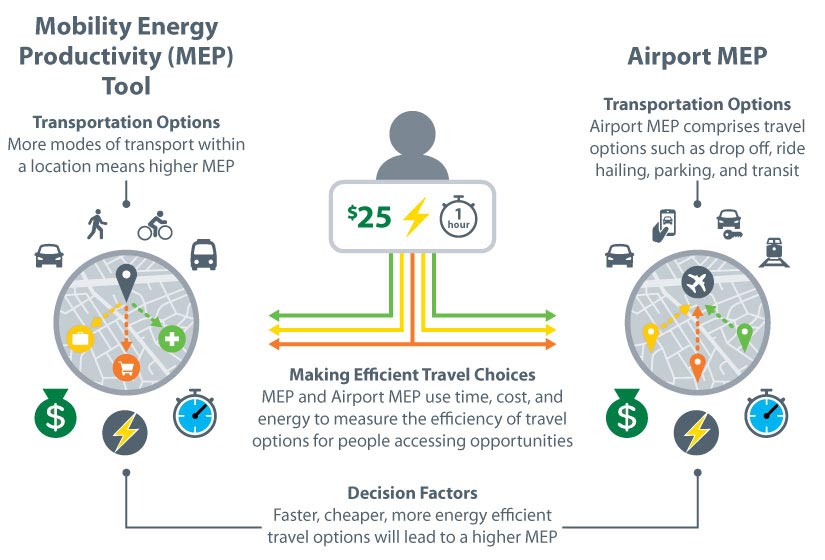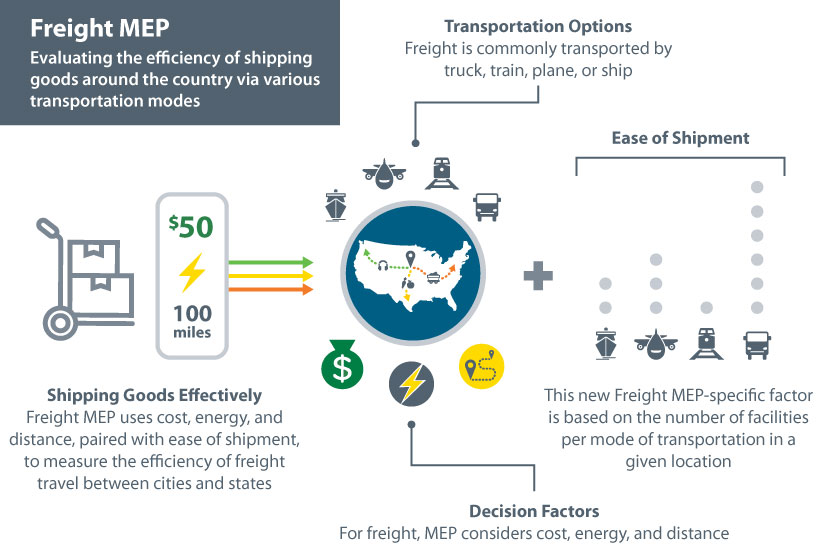MEP: Mobility Energy Productivity Tool
NLR's Mobility Energy Productivity tool, or MEP, quantifies the ability of an area's transportation system to connect individuals to goods, services, employment opportunities, and other activities while accounting for time, cost, and energy.
In other words, the tool measures how efficiently connected a place is.
Focus on People: Quantifying Transportation System Efficiency
The Mobility Energy Productivity tool offers an innovative approach to characterize, measure, and inform the movement of people within a given location or region. The ability to quantify mobility using MEP has the potential to create more livable communities that offer affordable transportation choices, create economic opportunities, and lead to a higher quality of life.

Building on accessibility theory, the basis of MEP is the proximity and convenience of access to a variety of goods, services, employment opportunities, and other activities reachable by various forms of mobility. Therefore, a location with access to many opportunities via a variety of travel modes, within a short amount of time, and with low energy and the least cost will have a high numeric MEP score.
MEP can be used to track changes in mobility within a single city or given location over time. It can measure current levels of mobility at a specific location and then determine how various technological advancements, services (e.g., ride-hailing, micromobility, electric vehicles, automated vehicles), and infrastructure investments (e.g., bike lanes, mixed-used development) may impact the mobility potential of that location over time.
When applied to major attractors such as airports (then dubbed the Airport MEP), it measures the ease of accessing an airport from anywhere in a city.
For more information about MEP, refer to the feature article A New Way To Measure Mobility Potential of Cities.
Focus on Freight: Quantifying Freight System Productivity
The Freight MEP quantifies the ease of shipping goods between cities or states via various modes. It can be used to quantify the productivity of current and future freight systems from the shipper’s perspective. It provides a mathematical framework for quantifying freight productivity—specifically by connecting freight demand to freight supply while accounting for inputs such as cost, energy, distance, time, logistics, and ease of shipping goods via various modes.

For more information about Freight MEP, refer to the news article New Tool Quantifies Productivity of Freight Mobility Systems.
Mobility Energy Productivity Publications
NLR publishes journal articles, conference papers, and reports about its mobility energy productivity analysis.
How To Cite MEP
If you use MEP for work described in a publication, please include a citation in your publication consistent with the following format:
"MEP: Mobility Energy Productivity Tool." ([YEAR]). NLR. Accessed [DATE]: www.nrel.gov/transportation/mobility-energy-productivity-tool.html.
Contact
Contact us to discuss your partnership interests or to learn about our custom analyses.
Share
Last Updated Dec. 6, 2025
